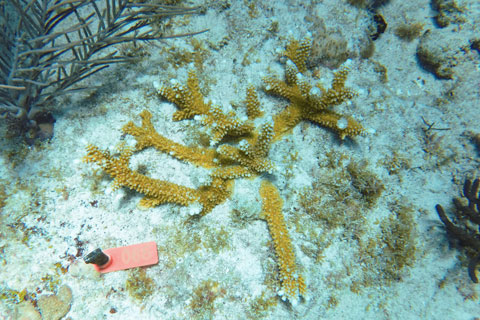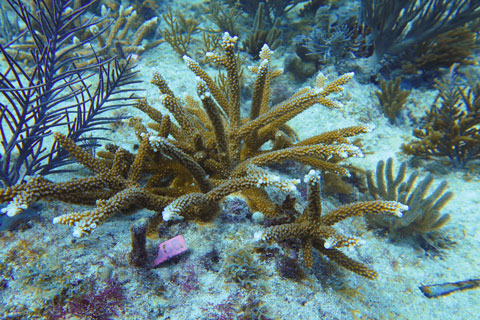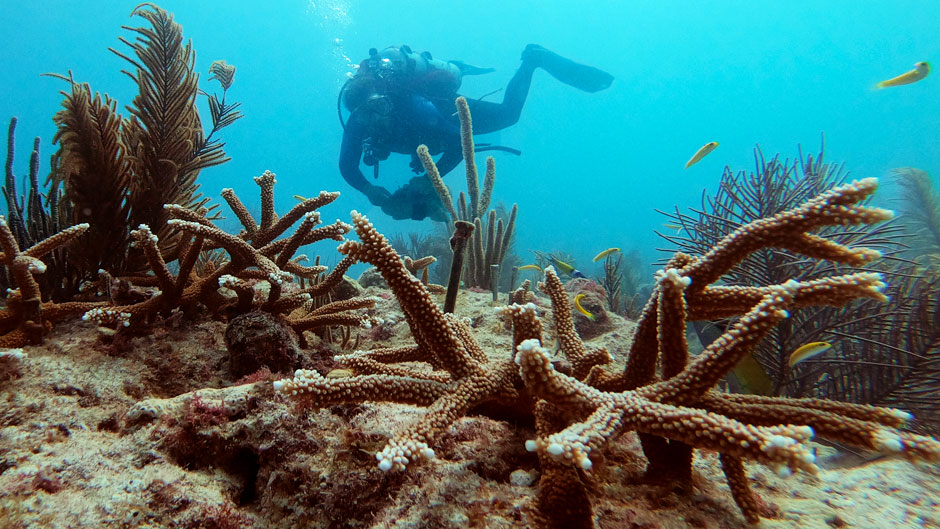Last week, University of Miami researchers Liv Williamson and Dalton Hesley went diving to check on coral fragments they planted off Key Biscayne just nine months earlier when they noticed a pleasant sight—many of the staghorn corals were flourishing.
“Because this is happening in the wild, there’s not as many things you can control like you can in a lab, so we were expecting to see variable results,” said Williamson, a Ph.D. candidate in the Coral Reef Futures Lab at the Rosenstiel School of Marine and Atmospheric Science. “But the fact that the corals have done so well validates that there is still so much room for research success.”
Williamson and Hesley are two scientists central to the University’s coral reef restoration effort, which is using innovative strategies to repopulate part of the Florida Reef Tract that has been decimated by storms, disease, and rising temperatures.
On their recent dive, Williamson and Hesley were checking two sites on Rainbow Reef, about three miles offshore from Key Biscayne, where they planted staghorn corals last spring. One area is part of a grant from Miami-Dade County, and another was funded by the NFL ahead of Super Bowl LIV, where 100 corals were planted to mark its centennial season. Those corals were sowed by University and Frost Science Museum researchers, as well as retired navy divers from the organization Force Blue. While they typically aim for at least 80 percent survival in corals they plant, Hesley said 95 percent of the corals they saw at these two sites were thriving.
“This shows that all the strategies that we have used to optimize growth are working,” said Hesley, a senior research associate for the Benthic Ecology and Coral Reef Restoration Lab, as well as the program manager for Rescue a Reef, both started by Diego Lirman, associate professor of marine biology and ecology. “Coral restoration is such an incredible vehicle for research, so there’s a lot of experimental design and investigation still to be done.”


Some of the novel techniques they used at the two sites included planting corals of different genotypes closer together and replanting larger colonies of coral, Hesley said. In addition, graduate student Joe Unsworth helped introduce a putty-like mix of cement and micro silica that the coral restoration team is now using to affix the new corals onto the reef, said Lirman. This is helping the team replant corals faster and at a lower cost. In the past, coral transplanting was done by hammering a nail into the reef and attaching a piece of coral with a plastic zip tie or by using epoxy glue, which is costly.
Started in 2007, Lirman’s Benthic Ecology and Coral Restoration lab has planted corals at more than 30 reef sites along the Miami-Dade County portion of the Florida Reef Tract.
As part of this effort, the Rosenstiel School has two underwater coral nurseries and one land-based coral nursery to propagate corals for restoration. Currently, the majority of the corals grown are staghorn, because this species is one of the fastest growing and it is listed as threatened under the Endangered Species Act. However, Lirman said they are also starting to grow and propagate brain coral and star coral for planting.
“Our initial goal was to recover the coral species that had been depleted in Florida, so we started with corals that were easier to grow but had undergone a drastic decline,” Lirman said. “Now we are growing brain corals and star corals, although they take a lot longer.”
Typically, staghorn corals grow about 10 to 15 centimeters per branch each year. At the sites visited last week, Hesley said they were definitely seeing that type of growth, if not more.
Lirman and Andrew Baker, associate professor of marine biology and fisheries in the Rosenstiel School, recently received a $6-million grant from the National Fish and Wildlife Foundation to lead a coral restoration project that will include up to 25 coral research sites and restore 125 acres of Florida’s coral reefs throughout Miami-Dade and Broward counties. The massive project—titled the Southeast Florida Coral Restoration Hub—will include collaboration from scientists at Nova Southeastern University, the Frost Science Museum, the Florida Aquarium, and SECORE International, applying a host of cutting-edge strategies to rejuvenate the coral colonies of South Florida, including growing corals that will withstand hotter temperatures as a result of climate change.
The team hopes to learn from the success at the Rainbow Reef sites and utilize similar strategies for the larger restoration project that is starting this year.
“We will be expanding on the reef restoration techniques we have honed over the years and trying some new ones as well,” Williamson said.

